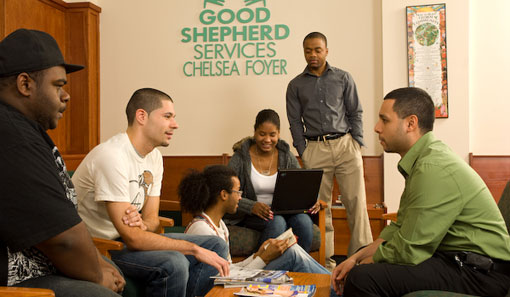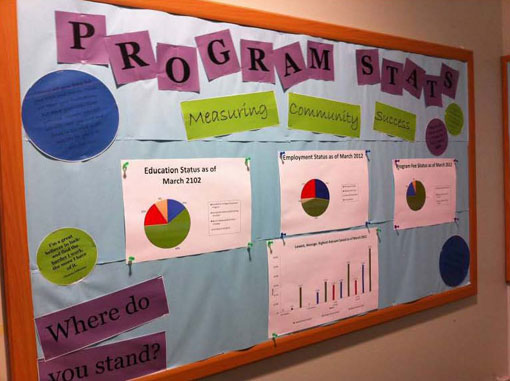
Residents at Good Shepherd Services' Chelsea Foyer program. Photos courtesy of Good Shepherd Services. Photography by Laura Dwight.
For more than 150 years, the children and young adults of New York City have had a stalwart ally in Good Shepherd Services. One of the longest-running social services agencies in the city, Good Shepherd Services provides an array of youth development, educational support and family service programs to over 27,000 program participants a year. The vast organization runs more than 70 programs across NYC, with each one striving toward a common goal: to help vulnerable youth and families make a safe passage to self-sufficiency through education, employment and other vital supports.
One of the jewels in Good Shepherd Services' crown is the Chelsea Foyer, a transitional supportive housing program for 40 young adults. The program is co-located at the Christopher, a Manhattan supportive housing residence operated by Common Ground. Since opening in 2004, the Chelsea Foyer has helped more than 200 young adults find stability after a tumultuous and often traumatic upbringing.
The program serves homeless youth, runaway youth and youth aging out of foster care who are at risk of becoming homeless.
According to Chelsea Foyer staff, a single key lies at the heart of the program’s success: data, and lots of it.
“What we found out at the Foyer very quickly is that we needed to know a lot about our program, and we needed to know it in a serious, data-informed way,” says Elizabeth Garcia, the Chelsea Foyer’ Program Director. “We collect too much data sometimes.”
With numbers guiding the way, the Chelsea Foyer helps young people develop the life and workforce skills they’ll need for independent living. It also helps keep staff vigilant in helping residents stay on track.
“Data has driven us to hold young people and ourselves more accountable,” says Adrian Rodriguez, the Chelsea Foyer’s Social Work Supervisor.
Program residents are asked to complete surveys before, during and after their time at Chelsea Foyer. Staff members then compare this data with the overall goals for the program. If staff members notice, for example, that employment rates dropped the previous month, they can move to ramp up those services.
“Each case manager can see if 75% of their young people are working or 30% of their young people are going to workshops or 10% are enrolled in education,” Garcia says. “So they understand how their work on a day-to-day basis is impacting the program as a whole.”
The staff also records notes from absolutely every resident interaction into a massive central database. This wealth of data gets entered into a quarterly progress report and even gets displayed in a common-space area for residents to see.

A public board at the Chelsea Foyer that shows where residents as a whole stand on education, employment and other barometers of success.
Along with helping to improve programs, data also serves another practical function: It helps ease funders’ minds. With concrete data, programs like the Chelsea Foyer can demonstrate their effectiveness in quantitative terms.
“What makes funders happy is that they actually have hard numbers to go with our anecdotal explanations,” Garcia said. “Now, we do both. We provide them with hard numbers, and then we provide them with the explanation of what those numbers mean.”
